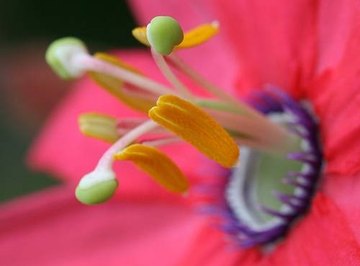
What is the pistil of a flower and what is its function? Basically, the pistil is the female reproductive part of a flower, and the function of a pistil is to receive pollen and produce seeds. Seeds are like plant babies, containing the genetic material and nutrition to nurture the next generation of the plant species.
To make seeds, an ovule of a plant – which is like a human egg – must be fertilized by pollen, which contains the male gametes, or sperm, of plants. A carpel of a plant includes three parts: stigma, style and ovary. A flower may have one or more carpels, and a pistil, by definition, consists of all of the carpels in a flower.
Parts of a Flower
A flower is actually made of specialized stems and leaves. Containing the reproductive parts of the plant, a flower can be male, female or both. Male parts are called stamens, which consist of filaments and anthers. Flower anthers produce pollen grains, which contain the male gametes of plants. Carpels are the female reproductive structures of plants, and a carpel includes a stigma, style and ovary. All the carpels together make up the plant pistil.
Flowers that contain both male and female parts are called perfect flowers, while those containing only male or female parts are called imperfect flowers. Some species are monoecious, meaning that they produce both male and female flowers on one plant. Others are dioecious, which means they produce male and female flowers on separate plants.
The sexual parts of flowers are adorned with non-reproductive parts, which are often unique and colorful. These sterile parts are called flower petals and sepals. The shape and color of flower petals and sepals may help attract pollinators like bees and butterflies to the blooms. Pollinators play an essential role in plant reproduction by transferring pollen from anthers to the stigma of the same species of plant, which may result in the fertilization of an ovule inside an ovary.
Flower Pistil Function
A flower pistil consists of all the carpels in the flower, which includes all of the stigmas, styles and ovaries of the blossom. A stigma is the part of a carpel that is receptive to pollen – it can be thought of as a pollen landing pad.
A style is a slender stalk that connects a stigma to a flower ovary. When pollen lands on a stigma, it moves through pollen tubes in the style to reach the ovules, which are protected within the ovary of the flower.
After fertilization, flower seeds develop within an ovary, which is located at the base of the pistil. So, the function of the pistil in flowers is to accept pollen, move pollen to the ovary and nurture developing seeds.
Some flowers are pollinated by wind, but others require help from insects, birds or bats. Some flowers have co-evolved with other species, meaning that they rely on specific pollinators to move pollen from their anthers to their stigmas. In these relationships, the survival of one species depends upon the existence of the other.
Diversity of Flowering Plants
Flowering plants, or angiosperms, are a diverse group numbering over 300,000 species with flowers of all shapes, sizes and colors.
Much of the diversity of angiosperms comes from their specialized reproductive structures. The arrangement, color and shape of flower petals, sepals, carpels and stamens is often a distinguishing feature of angiosperms, along with the size and shape of their leaves. Identification guides help users determine plant species through a series of observations about the characteristics of the foliage and flowers.
Becoming familiar with the terms used in botany is the first step in learning more about the plant kingdom. Knowing the difference between a pistil and an anther is an essential building block in the study of plant taxonomy – the branch of botany concerned with identifying, classifying and naming plants – and opens the door to a lifetime of learning about this fascinating subset of science.
References
About the Author
Meg Schader is a freelance writer and copyeditor. She holds a Bachelor of Science in agriculture from Cornell University and a Master of Professional Studies in environmental studies from SUNY College of Environmental Science and Forestry. Along with freelancing, she also runs a small farm with her family in Central New York.
Photo Credits
Creative Commons photo by Philip Bouchard
